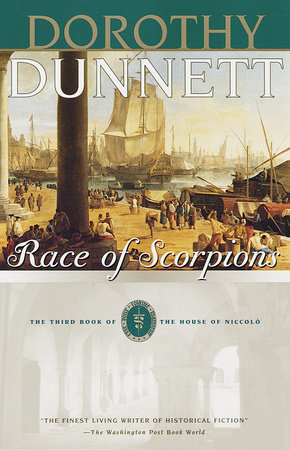Race of Scorpions Reader’s Guide
By Dorothy Dunnett


1. For Discussion: Race of Scorpions
What are the key ingredients in the nature of James of Lusignan, king-in-the-making, of Cyprus? Will he be a better king than his sister Carlotta? What are some of the forces that bring Nicholas vander Poele to take a hand in this making? Does his recent equivocal experience in Trebizond influence Nicholas here?
2. When we first see Katelina van Borselen she is conversing with the troubador King Ren? of Anjou while he is painting an illustration of his recently written allegory on the theme of "The Heart as Love’s Captive." How does this theme frame the relationship of Nicholas and Katelina? How do they each react to love’s captivity at the ancient black cone of Venus in Paphos? The ravine at Kalopetra? The shattered house in starving Famagusta?
3. Nicholas’s great public achievements during his stay in Cyprus are the modernization of the sugar producing processes at Kouklia and the victorious military and diplomatic assault at Famagusta. What did each enterprise satisfy in him? What did he learn from them? What elements of failure are in each of them?
4. The conflicts at this time in Cyprus will shortly produce the setting of the story which Shakespeare will use for his tragedy Othello. What echoes and intimations of this play, its characters and themes, do you find in Dorothy Dunnett’s novel?
5. How does the relationship between Nicholas and the young Diniz Vasquez replicate the nightmare version of Nicholas’s relationship with his family? The ideal version? Why do you think Nicholas brought Diniz to work in the dye factory? How does Jordan de Reberac tarnish this relationship at the end?
6. For Discussion: The House of Niccol?
Throughout the eight books of the House of Niccol? series a picture emerges of Sophie de Fleury, the mother of Nicholas, and of her centrality in the life of her son. Can you put this picture together now –the Sophie of rumor and gossip, the Sophie of Nicholas’s slowly revealed memories, of his maturer judgement, of Andro Wodman’s reporting? Are there still some mysteries and obscurities in this portrait?
7. The House of Niccol? series offers a sustained and in many ways highly sophisticated version of the changes in intellectual, political and psychological structures which mark the transition from the medieval to the modern world. But like any good set of historical novels it abounds too in individual scenes and characters of great emotional, dramatic, and visual power, or stylistic verve, "set pieces" which hang in the memory even longer, perhaps, than the plot or the author’s philosophy of history. What are some of your favorites here–scenes of comic impact or tragic illumination? Best-drawn villain or victim, most vexatious female adolescent? Most breathtaking fight or chase? Most engrossing moment of romance? Most stunning surprise?
8. At the opening of the second volume of the series, and at the closing of the last volume, the voice of an astrologer-character replaces that of the novelist-narrator. What do you make of this–some invitation to compare and contrast those two professions?
9. Some readers will have come to the Niccol? series after reading the Lymond Chronicles, to which they are a ‘prequel’; others have now finished the Niccol? series and will go on to the sequel, the Lymond Chronicles. What are some of the dividends of doing it the first way? The second way? How (after a reading of both) are these two heroes, these two worlds, these two intricate plots, alike and different?
Just for joining you’ll get personalized recommendations on your dashboard daily and features only for members.
Find Out More Join Now Sign In